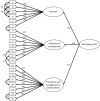Nurses' evidence-based knowledge and self-efficacy in venous access device insertion and management: Development and validation of a questionnaire
- PMID: 38967938
- PMCID: PMC11225607
- DOI: 10.1002/nop2.2177
Nurses' evidence-based knowledge and self-efficacy in venous access device insertion and management: Development and validation of a questionnaire
Abstract
Aim: To develop and psychometrically test an instrument to assess nurses' evidence-based knowledge and self-efficacy regarding insertion and management of venous access devices (short peripheral catheter (SPC), long peripheral catheter/midline (LPC) and PICC) and the management of totally implantable central venous catheter (Port) in adult patients.
Design: Multicenter cross-sectional observational study with questionnaire development and psychometric testing (validity and reliability).
Methods: An evidence-based instrument was developed including a 34-item knowledge section and an 81-item self-efficacy section including four device-specific parts. Nineteen experts evaluated content validity. A pilot study was conducted with 86 nurses. Difficulty and discrimination indices were calculated for knowledge items. Confirmatory factor analyses tested the dimensionality of the self-efficacy section according to the development model. Construct validity was tested through known group validity. Reliability was evaluated through Cronbach's alpha coefficient for unidimensional scales and omega coefficients for multidimensional scales.
Results: Content validity indices and results from the pilot study were excellent with all the item-content validity indices >0.78 and scale-content validity index ranging from 0.96 to 0.99. The survey was completed by 425 nurses. Difficulty and discrimination indices for knowledge items were acceptable with most items (58.8%) showing desirable difficulty and most items (58.8%) with excellent (35.3%) or good (23.5%) discrimination power, and appropriate to the content. The dimensionality of the model posited for self-efficacy was confirmed with adequate fit indices (e.g., comparative fit index range 0.984-0.996, root mean square error of approximation range 0.054-0.073). Construct validity was determined and reliability was excellent with alpha values ranging from 0.843 to 0.946 and omega coefficients ranging from 0.833 to 0.933. Therefore, a valid and reliable tool based on updated guidelines is made available to evaluate nurses' competencies for venous access insertion and management.
Keywords: central venous catheters; nurses; peripheral catheterization; psychometric properties; questionnaire; vascular access devices.
© 2024 The Author(s). Nursing Open published by John Wiley & Sons Ltd.
Conflict of interest statement
The authors have declared no conflict of interest.
Figures




References
-
- Alexandrou, E. , Ray‐Barruel, G. , Carr, P. J. , Frost, S. A. , Inwood, S. , Higgins, N. , Lin, F. , Alberto, L. , Mermel, L. , & Rickard, C. M. (2018). Use of short peripheral intravenous catheters: Characteristics, management, and outcomes worldwide. Journal of Hospital Medicine, 13(5), E1–E7. - PubMed
-
- Badger, J. (2019). Long peripheral catheters for deep arm vein venous access: A systematic review of complications. Heart & Lung, 48(3), 222–225. - PubMed
Publication types
MeSH terms
Grants and funding
LinkOut - more resources
Full Text Sources

